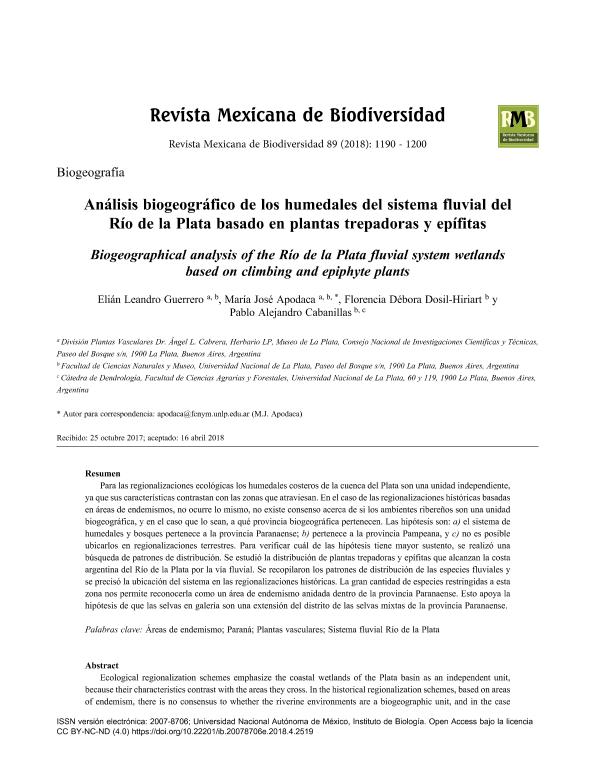Artículo
Para las regionalizaciones ecológicas los humedales costeros de la cuenca del Plata son una unidad independiente,ya que sus características contrastan con las zonas que atraviesan. En el caso de las regionalizaciones históricas basadasen áreas de endemismos, no ocurre lo mismo, no existe consenso acerca de si los ambientes ribereños son una unidadbiogeográfica, y en el caso que lo sean, a qué provincia biogeográfica pertenecen. Las hipótesis son: a) el sistema dehumedales y bosques pertenece a la provincia Paranaense; b) pertenece a la provincia Pampeana, y c) no es posibleubicarlos en regionalizaciones terrestres. Para verificar cuál de las hipótesis tiene mayor sustento, se realizó unabúsqueda de patrones de distribución. Se estudió la distribución de plantas trepadoras y epífitas que alcanzan la costaargentina del Río de la Plata por la vía fluvial. Se recopilaron los patrones de distribución de las especies fluviales yse precisó la ubicación del sistema en las regionalizaciones históricas. La gran cantidad de especies restringidas a estazona nos permite reconocerla como un área de endemismo anidada dentro de la provincia Paranaense. Esto apoya lahipótesis de que las selvas en galería son una extensión del distrito de las selvas mixtas de la provincia Paranaense. Ecological regionalization schemes emphasize the coastal wetlands of the Plata basin as an independent unit, because their characteristics contrast with the areas they cross. In the historical regionalization schemes, based on areas of endemism, there is no consensus to whether the riverine environments are a biogeographic unit, and in the case that they are, to which biogeographic province they belong. The positions about this topic can be summarized as: a) the wetland and forests system belongs to a district within the Paraná province; b) belongs to the Pampean province, and c) it is not possible to locate them in terrestrial regionalizations. In order to verify which of the hypotheses is better supported, an exploration for common distribution patterns was made, based on the concept that nestednes of areas of endemism is the essential tool for a regionalization. The geographic distribution of the climbing plants and epiphytes species that reach the Argentine coast of the Río de la Plata by the fluvial route was studied. Recurrent patterns of geographic distribution of river species were achieved and the location of the system in the biogeographic units recognized in the historical regionalizations was specified. The large number of species restricted to this area allows us to recognize it as an area of endemism nested within the Paraná province. This supports the hypothesis that gallery forests can be considered an extension of the Mixed Forests district of the Paraná province.
Análisis biogeográfico de los humedales del sistema fluvial del Río de la Plata basado en plantas trepadoras y epífitas
Título:
Biogeographical analysis of the Río de la Plata fluvial system wetlands based on climbing and epiphyte plants
Guerrero, Elián Leandro ; Apodaca, María José
; Apodaca, María José ; Dosil Hiriart, Florencia Débora
; Dosil Hiriart, Florencia Débora ; Cabanillas, Pablo Alejandro
; Cabanillas, Pablo Alejandro
 ; Apodaca, María José
; Apodaca, María José ; Dosil Hiriart, Florencia Débora
; Dosil Hiriart, Florencia Débora ; Cabanillas, Pablo Alejandro
; Cabanillas, Pablo Alejandro
Fecha de publicación:
12/2018
Editorial:
Universidad Nacional Autónoma de México. Instituto de Biología
Revista:
Revista Mexicana de Biodiversidad
ISSN:
1870-3453
Idioma:
Español
Tipo de recurso:
Artículo publicado
Clasificación temática:
Resumen
Archivos asociados
Licencia
Identificadores
Colecciones
Articulos(CCT - LA PLATA)
Articulos de CTRO.CIENTIFICO TECNOL.CONICET - LA PLATA
Articulos de CTRO.CIENTIFICO TECNOL.CONICET - LA PLATA
Citación
Guerrero, Elián Leandro; Apodaca, María José; Dosil Hiriart, Florencia Débora; Cabanillas, Pablo Alejandro; Análisis biogeográfico de los humedales del sistema fluvial del Río de la Plata basado en plantas trepadoras y epífitas; Universidad Nacional Autónoma de México. Instituto de Biología; Revista Mexicana de Biodiversidad; 89; 4; 12-2018; 1190-1200
Compartir
Altmétricas



